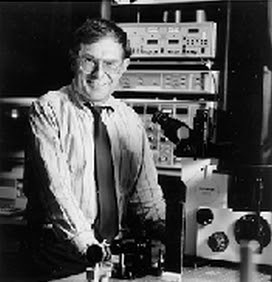"The basic idea behind this field of research is to follow cellular processes---both normal and abnormal---by monitoring physical properties inside the cell. There's a long history of research on the chemistry happening inside the cell, but now we're getting interested in measuring the physical properties, because physical and chemical processes are related," said Kopelman, who is the Richard Smalley Distinguished University Professor of Chemistry, Physics and Applied Physics.
With a diameter of about 30 nanometers, the spherical device is 1,000-fold smaller than existing voltmeters, Kopelman said. It is a photonic instrument, meaning that it uses light to do its work, rather than the electrons that electronic devices employ.
Kopelman's former postdoctoral fellow Katherine Tyner, now at the U.S. Food and Drug Administration, used the nano-voltmeter to measure electric fields deep inside a cell---a feat that until now was impossible. Scientists have measured electric fields in the membranes that surround cells, but not in the interior, Kopelman said.
With the new approach, the researchers don't simply insert a single voltmeter; they're able to deploy thousands of voltmeters at once, spread throughout the cell. Each unit is a single nano-particle that contains voltage-sensitive dyes. When stimulated with blue light, the dyes emit red and green light, and the ratio of red to green corresponds to the strength of the electric field in the area of interest.
Tyner's measurements revealed surprisingly high electric fields in cytosol---the jellylike material that makes up most of a cell's interior.
"The standard paradigm has been that there are zero electric fields in cytosol," Kopelman said, "but all of the 13 regions we measured had high electric field strength---as high as 15 million volts per meter." In comparison, the electrical field strength inside a typical home is five to 10 volts per meter; directly under a power transmission line, it's 10,000 volts per meter. Kopelman, Tyner and coauthor Martin Philbert, professor of environmental health sciences and associate dean for research at the U-M School of Public Health, published a report on the nano-voltmeter and their paradigm-shattering findings in Biophysical Journal in August.
Those findings leave the researchers wondering why electrical fields exist inside cells.
"I don't know the answer to that," Kopelman said. "I suspect that finding out exactly what's going on will keep a lot of people working for a long time." But the ability to measure internal cellular electrical fields should aid in that endeavor.
It's already known that changes in electrical fields associated with membranes can play a role in diseases such as Alzheimer's, and researchers have been exploring the use of externally-applied electric fields to stimulate wound healing and nerve growth and regeneration.
As for the U-M researchers, Philbert, a neurotoxicologist, is exploring how intracellular fields change with exposure to nerve toxins, and Kopelman, who is collaborating with Philbert and researchers in the U-M medical school on new approaches to cancer detection and treatment, is interested in comparing electric fields in cancerous and non-cancerous cells. But they're also open to other avenues of research, Kopelman said.
"One reason for going to the ASCB meeting is to confer with colleagues and strategize about where to go next." ###
Contact: Nancy Ross-Flanigan rossflan@umich.edu 734-647-1853 University of Michigan
The researchers received funding from the Defense Advanced Research Project Agency BioMagnetics program, the National Institutes of Health and the National Science Foundation - Division of Materials Research.
RELATED:
- For more information on Kopelman
- More on Philbert
- American Society for Cell Biology
- American Society for Cell Biology















No comments:
Post a Comment